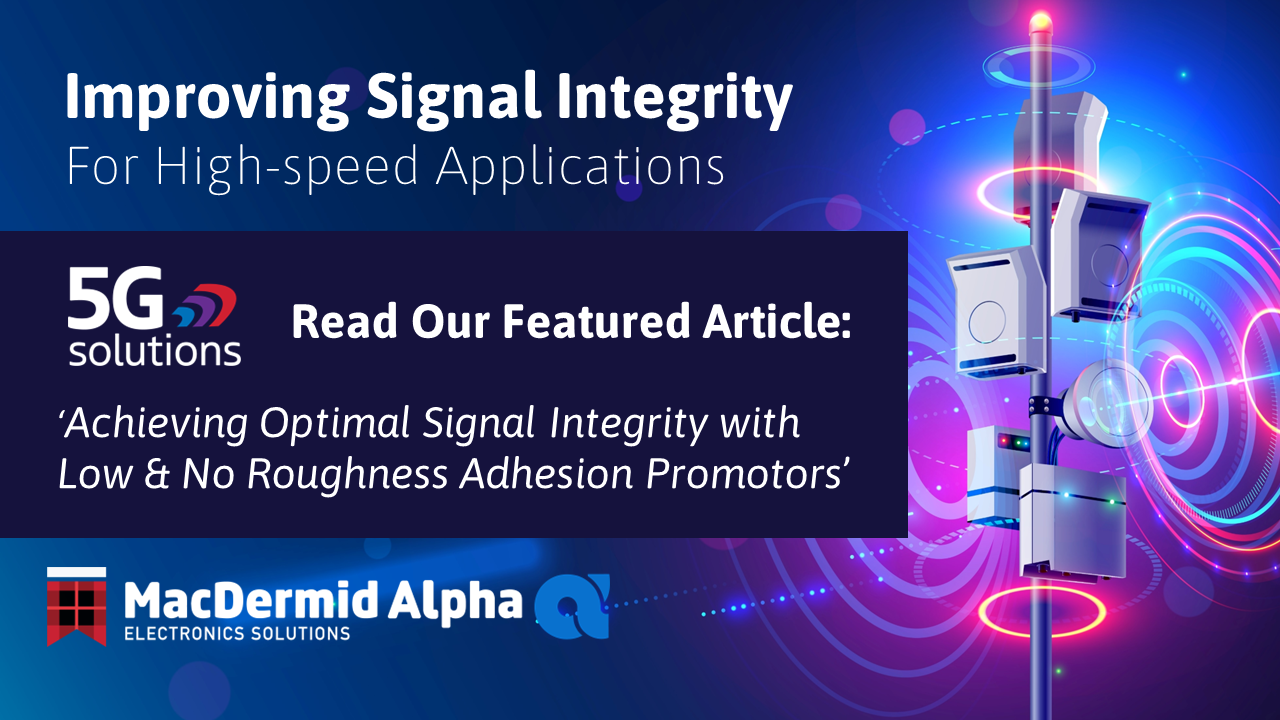Achieving Optimal Signal Integrity with Low and No Roughness Adhesion Promotors


Achieving Optimal Signal Integrity with Low and No Roughness Adhesion Promotors
In the manufacture of advanced electronics, high-speed signal requirements are becoming common. As a result, printed circuit board (PCB) manufacturers, IC Substrate fabricators, and original equipment manufacturers (OEMs) are looking for solutions to enable them to build and design circuit boards that transmit at higher signal speeds than previously possible with standard manufacturing processes.
Causes of signal loss
One of the key concerns for PCB fabricators and OEMs is maintaining signal integrity in high frequency electronics applications. Signal integrity refers to a printed circuit board’s ability to deliver electrical signals with minimal to no distortion. Signal loss is largely caused by design and material properties and exacerbated at higher frequencies. Addressing improvement through design and materials can be costly and has led fabricators and manufacturers to consider other factors which improve signal loss using less costly solutions.
As signal speeds increase, the effect of surface roughness becomes more pronounced since the signal travels closer to the surface of the conductor. The conductor trace roughness can contribute up to a 7% loss factor in signal integrity. With increased data rates and higher frequency signals driving the need for smoother copper, the surface roughness of the copper conductor has become an area of focus in the PCB industry. Additionally, as traces increase in density and thinner copper is used, copper etch budget is critical. As a result, low and no-etch innerlayer adhesion processes are becoming increasingly important to reduce circuit roughness for decreased signal loss and to minimize the amount of copper removed to retain fine circuit geometries.
Overcoming signal loss
MacDermid Alpha’s low roughness adhesion promotion solutions, MultiBond and M-Speed HF processes, are at the forefront of technological achievement for the precise tuning of copper surfaces. They provide innerlayer adhesion processes with minimal surface roughness.
Low-etch
MultiBond 500 is a first generation low-etch oxide alternative designed for laser direct drilling applications. Due to its lower-etch depth and lower roughness profile, the MultiBond 500 process enables improvements in laser direct drilling of vias while providing optimized topography for the most demanding adhesion requirements. The process provides a highly uniform dark oxide alternative coating for lasering. From start to finish, MultiBond 500 removes less than 1 micron of copper from the surface. Additionally, the combination of low-etch and high copper solution capacity results in reduced process waste.
Excellent adhesion
Our revolutionary low-etch oxide alternative, M-Speed HF, delivers a very low-profile surface topography to ensure maximum signal speeds, meeting the needs of controlled impedance and optimizing signal integrity in high-speed, low loss applications. The M-Speed HF process achieves this industry-leading performance in as few as three process steps. The process combines a holistic approach for dry film adhesion and innerlayer bonding using clean, surface prep, and post-treatment chemistries. These three process steps allow for excellent surface adhesion to a wide variety of substrates as well as unparalleled innerlayer bonding strength. M-Speed HF provides outstanding adhesion and thermal resistance despite lower surface topography and lower peak-to-valley roughness on the copper surface, making it superior for fine traces by retaining copper geometries. M-Speed HF provides flexibility for processing needs while reducing process waste as well as chemical consumption.
Next generation technology
As MacDermid Alpha continues to develop leading technologies our latest innovation, NeoBond, is a next-generation no-etch oxide process for copper adhesion promotion. With no etching of copper, NeoBond retains fine feature geometries with no change to the incoming copper surface morphology. Therefore, optimal signal integrity is achieved, benefiting a wide variety of high-frequency applications. NeoBond is compatible with high-speed foils (i.e., HVLP), electroplated copper surfaces, and high-speed resin systems. The process ensures no bulk conductor loss in IC substrate fabrication thereby retaining the electrical performance. In addition, NeoBond has undergone extensive reliability testing and maintains excellent thermal stability and superior bond strength, making it an excellent choice for next-generation high-speed PCB and IC Substrate applications.
With our range of innovative low and no-etch adhesion promotion technologies, MacDermid Alpha is leading the industry in providing processes to ensure improved signal speeds for today’s advanced electronics including internet infrastructure, IC substrates, and 5G applications.
Partner with us to Power Your Path to optimal signal integrity.
Want to connect with our experts? Let's get in touch.
